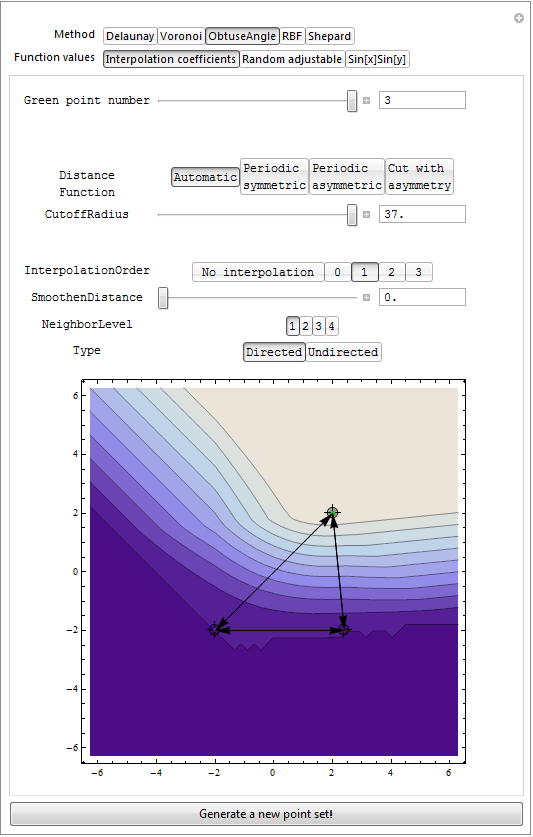| Obtuse Tutorial | Tutorials » |
Interpolation interactive demo
The interactive example below of scattered point interpolation is interactive only in the notebook variant of this page, not in the HTML version. A related demonstration, which is working in the free Mathematica Player, can be downloaded at http://demonstrations.wolfram.com/ObtuseAngleShadowingNetworksAndDistanceBasedInterpolation/
In the interactive example, you might change the methods, some option settings and the point locations. The controls interact with each other, and inactive controls are hidden. For example, for the method "Delaunay" you do not see any options, because there are no additional options to interpolation with the Dealunay method. For the function values setting "Interpolation coefficients", the contour plot shows the weight of the function value of the green control point in different interpolation points. This corresponds to putting the function value to one in the green control point, and putting it to zero in all other control points. For the function values setting "Random adjustable", the function values are random real numbers, connected to the control points. A slider is provided for changing the function value in the green point. For the function values setting "Sin[x]Sin[y]", the function value in each point is the value of Sin[x]Sin[y] in that point. If the control point is moved, the function value is adjusted to the new position. You might add more control points by Alt+Click, and you can drag the control points around.
The distance function choices also require a little explanation. "Automatic" implies here the usual squared euclidean distance. "Periodic symmetric" implies the distance function sin2( x)+sin2(
x)+sin2( y), and "Periodic unsymmetrical" implies the modulated variant
y), and "Periodic unsymmetrical" implies the modulated variant  . "Cut with asymmetry" means that we have a cut between {-2, 0} and {2,0}. Distances between points are never measured across the cut. They are instead measured along straight lines around the cut (passing one of the end points), and they are always measured counterclockwise from the first point to the second. These peculiar distance functions have been chosen to "stress-test" the mathematical routines, but at the same time they illustrate the power of distance-based interpolation, which can be used not only in multidimensional geometry, but also in strange topologies.
. "Cut with asymmetry" means that we have a cut between {-2, 0} and {2,0}. Distances between points are never measured across the cut. They are instead measured along straight lines around the cut (passing one of the end points), and they are always measured counterclockwise from the first point to the second. These peculiar distance functions have been chosen to "stress-test" the mathematical routines, but at the same time they illustrate the power of distance-based interpolation, which can be used not only in multidimensional geometry, but also in strange topologies.
 |
More about
InterpolationMethodDelaunay
InterpolationMethodObtuseAngle
InterpolationMethodRBF
InterpolationMethodShepard
InterpolationMethodVoronoi
The Code
| In[24]:= |
